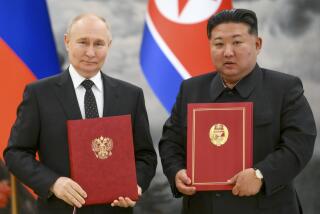Market Scene : Forging a New Far Eastern Alliance : * Russia’s remotest outposts strike out on their own to join prosperous Pacific Rim.
- Share via
KHABAROVSK, Soviet Union — Struggling to avoid economic collapse, the Soviet Far East is increasingly turning its back on Moscow and looking to integrate into the fast-growing economy of the Pacific Rim.
For nearly seven decades, the Far East has served as a Soviet bastion against Asia, a remote outpost whose only purpose was to defend against alien incursions and send raw materials back to Moscow.
Now, local governments in the Far East are ignoring Moscow and are openly scrambling to obtain joint ventures with Japan, South Korea and businesses as far away as the Pacific Coast of the United States. Even China, the former archenemy, has become a major trading partner in the Soviet Far East.
“The government in Moscow is bankrupt and can no longer help us,” said Alexander Kaluser, economics correspondent of Khabarovsk’s Pacific Star newspaper. “Now we are reorienting toward the Eastern countries, looking especially at how places like Hong Kong and Taiwan developed.”
Lacking virtually any infrastructure or advanced industry, the Far East is increasingly peddling its vast resources of coal, oil, timber and gold to Asian nations in exchange for hard currency. It is importing food and consumer goods in return.
Under previous regimes, the Soviet Far East primarily developed a military-industrial complex and now desperately needs foreign investments to upgrade and build its other industries. It is looking to Asian nations with experience in export-oriented industries to provide the capital while the Soviets provide land, raw materials and cheap labor.
Yuri M. Polyntsev has set up a prospering joint venture that caters to the commercial and personal needs of visiting Japanese business executives, offering everything from deluxe hotel suites in a former Communist Party building to fax and secretarial services.
“Two years ago, we did not have a single representative office of a foreign company in Khabarovsk,” Polyntsev said. “Now there are 14 permanent Japanese offices here and dozens of Japanese businessmen arriving every day. We’re fully booked for months ahead.”
Areas of the Far East are so eager to attract Asian investment that many are establishing so-called free economic zones to give them more latitude to offer tax and customs advantages to foreign companies not available elsewhere in the country.
Already, the port city Nakhodka, Sakhalin island and the small Jewish Autonomous Region have declared themselves free economic zones. The Khabarovsk territory is on the verge of a similar move.
Pavel A. Minaker, a senior Soviet economist based in the Far East, has drawn up a sweeping plan to have the entire region declared a free economic zone independent from the rest of the country.
Under Minaker’s plan, in two years the Far East would adopt its own convertible ruble and allow the region’s businesses to sell their products to whomever offers the best deal, whether at home or abroad. That would raise hard currency to invest in the area’s fledgling industrial base.
Not surprisingly, Minaker’s plan is supported by political figures in the Far East but opposed by Moscow, which stands to lose the input of the region’s raw materials. Business leaders also question the ability of regions to isolate themselves from the Soviet economy.
“You cannot cure just an ear or a finger on a sick body,” said Alexander Radushkevich, editor of the Pacific Business News in Vladivostok. “The patient should be cured once and for all.”
Some Soviet business leaders argue that the region’s relative backwardness may be an advantage when it comes to new investment.
“It’s easier to build a new infrastructure from scratch than to try to rehabilitate the old system,” said Mikhail S. Dalman, director of Vladivostok’s Acfes Corp., the largest private contractor in the Far East.
The Russian Federation, which includes all of the Far East and Siberia, has granted limited autonomy to industry in the region, allowing it to retain 30% of the value of its production instead of sending it all to Moscow. But that money will go to local governments to buy food and other commodities and will not be available to the factories to increase output or efficiency.
So far, business ties with Asian countries have been primarily limited to sales of raw materials and purchases of manufactured goods. Foreign investment is arriving at an agonizingly slow pace.
Several Japanese firms have set up joint ventures to process fish, with the companies sending their product overseas. The problem of ruble convertibility--it is still not possible to exchange rubles for dollars at a bank--has put a brake on investment.
One Japanese company has established a Japanese restaurant called Sapporo in Khabarovsk. In addition to offering genuine Japanese cuisine, the restaurant is a unique exchanger of foreign currency. It takes in rubles on the two floors that cater to Soviet customers and receives Japanese yen on the top floor, which serves Japanese patrons.
Japanese firms are constrained by the lingering political dispute between their government and the Soviet Union over the ownership of the four small islands at the southern end of the Kuril chain, which the Soviet Union seized from Japan after World War II. A breakthrough in the 46-year-old disagreement recently appeared closer when some Soviet officials began to suggest that they would be prepared to return the islands to Japan. But strong opposition developed on the islands--now home to about 26,000 people, mostly Russians--and nearby Sakhalin, with Russian nationalism the rallying force.
Until recently, Japan has given the Soviets small amounts of aid and linked future financial assistance to resolution of the Kuril dispute. But last month, Tokyo provided $2.5 billion in trade credits and humanitarian assistance with no linkage.
Some Japanese sources have indicated that the Japanese may be willing to pay as much as $28 billion to resolve the dispute.
While the Japanese have been slow in investing, South Korea has rushed forward with $3 billion in bank loans and $300 million in commercial credits.
Because of Asia’s proximity, Soviet economic specialists believe that much of the money forthcoming from the industrialized countries there will be spent in the Soviet Far East and Siberia, one of the primary troves of Soviet raw materials.
“Foreign companies are holding back, watching what will happen to our economy,” said Alexander Leventhal, an investment specialist with the Khabarovsk regional government. “Who wants to invest in this uncertain climate?”
Valuable Neighbors
Local governments in the Soviet Far East are looking to Pacific Rim nations to obtain business ties and tips. SOVIET UNION DECLARED FREE ECONOMIC ZONES Nakhodka Sakhalin island Jewish Autonomous Region CONSIDERING DECLARATION AS FREE ECONOMIC ZONE Khabarovsk JAPAN Provided $2.5 billion in trade credits and humanitarian assistance to Soviets in October. Before that, most aid was linked to resolution of dispute over who controls Kuril Islands. SOUTH KOREA Provided $3 billion in bank loans and $300 million in commercial credits to Soviets. CHINA Former enemy has become a key Soviet trading partner.
Buying and Selling With the Soviets
Soviet foreign trade with selected nations. In millions of U.S. dollars.
Trade Exports Imports balance 1989 1990 1989 1990 1989 1990 United States 842 952 4,553 3,686 -3,711 -2,734 Japan 2,134 2,455 3,397 3,595 -1,263 -1,139 Canada 61 94 656 1,135 -595 -1,042 China 2,111 2,358 1,722 2,841 389 -484 Australia 28 30 933 387 -905 -356 Singapore 93 98 159 356 -66 -258 New Zealand 25 22 203 231 -178 -209 South Korea 152 291 68 415 85 -124 Malaysia 20 40 243 160 -222 -120 Mexico 7 14 92 54 -84 -41 Thailand 57 99 351 116 -294 -17 Philippines 9 21 26 20 -17 1 Hong Kong 88 95 43 70 45 25
1990 figures are for the first nine months of the year.
Sources: Goskomstat, USSR External Trade, Soviet Foreign Trade Yearbook, PlanEcon estimates
More to Read
Sign up for Essential California
The most important California stories and recommendations in your inbox every morning.
You may occasionally receive promotional content from the Los Angeles Times.












